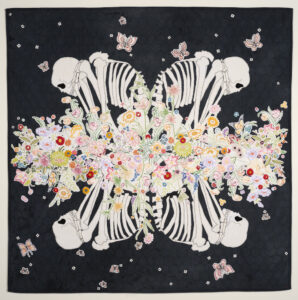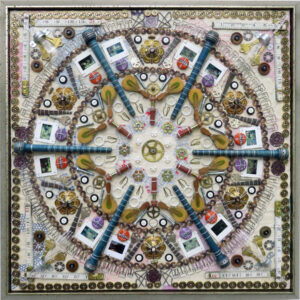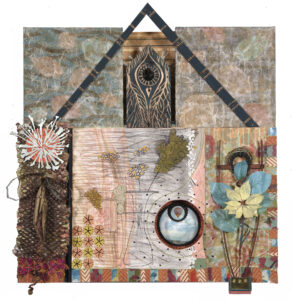Learn More: “Textile Narratives, Vintage, Found & Transformed” with Maggy Rozycki Hiltner, Susan Lenz & Jennifer Lee Morrow
July 23, 2021
SDA-sponsored Textile Talks provide engaging theme-focused presentations by member artists. In April, Textile Narratives: Vintage, Found & Transformed, with Maggy Rozycki Hiltner, Susan Lenz & Jennifer Lee Morrow, along with moderator Merill Comeau, generated enthusiastic audience questions with insufficient time for answers. Revisit this popular program and read on for a continuation of our Q&A. But first, a basic description: Materials matter to Maggy Rozycki Hiltner, Susan Lenz, and Jennifer Lee Morrow. It is the thrill of the hunt, the serendipity of the discovery, and the buzz of appropriate appropriation that informs their studio practices. This program illustrates how they find, are guided by, and transform objects to create their own stories layered on those of the past.
MAGGY ROZYCKI HILTNER

Maggy Rozycki Hiltner, Perennial, 2018. Linen, found embroidery, found quilt, hand-stitched embroidery, hand-stitched applique, 57 x 57 in.
Do you have a concept when you begin a piece? Improvise?
I usually start with a rough sketch. Sometimes I have a found illustration or piece of embroidery that I want to respond to. I definitely improvise as I go along. illustrators who influence me are Sheilah Beckett, Barbara Bradley, Zerna Sharp, Lois Lenski, Kay Thompson. I do sometimes use cut up vintage quilts.
Why are there mainly children added to the old embroideries?
I like the Dick-and-Jane-style kids as idealized people. They are so “perfect”, but I don’t believe that. We all have childhood in common—I hope a viewer can jump in and relate to some of the imagery.
After you create your “patch” or embroidered cloth, do you glue it to the backing board? Or do you wrap cloth around the backing board and stitch your piece to the cloth? What kind of backing board do you use?
I use Wonder Under to fuse all my layers. There is no backing board, just many thicknesses of cloth. There are knots and threads on the back but generally tidy. Backs of my pieces are on Instagram. If the piece gets framed, the framer mounts it to the acid-free mat board with archival stitchery tape. A spacer keeps the plexi glazing off of the fabric.
SUSAN LENZ

Susan Lenz, Mandala XV, 2020. Hand stitched on a section of an antique Grandmother’s Flower Basket quilt section, found objects, 28.5 x 28.5 in.
Size range? How do you handle the weight of your objects? Do you first build up the base or apply the objects and then “fortify”? Do you reinforce your quilt ground?
My mandalas range from a single, ten-inch vintage quilt block to larger sections measuring 32″ square. The presentation of the mandala series was worked out before the first one was stitched. I don’t use any glue. Everything is hand-stitched in place, with some found objects having pre-drilled holes.
Each piece is stitched while the three layers of the vintage quilt section are stapled to a stretcher bar. After all the objects are attached, the work is removed from the stretcher bar and a piece of acid-free foam core is glued/stapled to the face of the stretcher bar. The piece is then re-stapled to the stretcher bar. Using buttonhole thread, I stitch long rows of running stitch through both the piece and the acid-free foam-centered board. These rows are every two to three inches apart, both vertically and horizontally. These stitches evenly distribute the weight of the found objects so that no part is supporting more than a two- to three-inch section. For particularly heavy objects, I will stitch around those objects when attaching the piece to the foam-centered board. An illustrated example of this presentation is on my blog.
JENNIFER LEE MORROW

Jennifer Lee Morrow, Shelter in Place, 2020. Found & altered papers, found wood, drawing, bait bag, nails, thread, wire, screws, staples, waxed linen, burnt balsa, fake flowers, metal scrap, & wood carving , 34 x 31 x 7 in.
When you use “other people’s art” how do you think about copyright issues?
I use friends and other artists work with permission. I only “steal” things my family makes; they know that is always a possibility. If I use a commercial reproduction of someone’s work, I transform it enough that it doesn’t seem like infringement.
You seem to have lots of layers and levels. Are these on canvas? How do you attach surfaces to structure? How do you cope with the edges?
The layers are mostly paper, glued and stitched together. Once the piece is close to completion, I glue the papers to primed ¼” plywood – sometimes called luan or floor underlayment, using Sobo glue. Often I also use staples, nails, tacks, and stitching through drilled holes to physically join the paper to the structure along with the adhesive. Occasionally I will use encaustic wax to adhere papers to each other and to the structure. I work all visible surfaces, including the sides of my shallow box constructions. I often continue the front face material onto the sides. I also add related materials so there is something to look at from all angles. When I am joining materials, I pay close attention to the edges where things join, adding an unexpected sliver of color or reflective material or stitching to emphasize the joint. I have several pieces in beginning stages in the studio but I usually only finish one at a time – unless a piece splits as I am creating it. I work so intuitively that quantifying hours is tough.
Are your pieces considered quilts or collage?
I like the word bricolage (construction or creation from a diverse range of available things) – collage implies more similarity in the materials than I work with. I consider myself a mixed media artist – though there may be a more up-to-date term.
Can you tell us more about paper yarns and paper knitting?
You can find paper yarn at Habu Textiles. I also use raffia. I knit loosely on very large needles, purposely varying tension, and adding and dropping stitches to make a random net like effect. Often I stretch the knitting to flatten it and enlarge the openings. Then I stitch it to a piece of paper or other surface. I also use disintegrating bait bags and food netting.
Can the artists talk about the best way to earn money from their art. Do they support themselves with their art? Where do they sell other than at a show? What platforms do they use?
Susan: I have gallery representation. I sell my work directly to those who contact me.
Maggy: If I focus on making money, I tend to design sellable products rather than create challenging exciting work. I might get commercial attention from individual buyers, but museums and curators seem to notice larger, less “house-friendly” more conceptually challenging art. I want to make things as true to my vision without being swayed by market trends. To make money, I also look to teaching, speaking, and jurying jobs, grants, and awards. The money from sales of my art or products (t-shirts, postcards, tote bags, comic books) goes back into my studio account to cover art-related expenses. Right now, my goal is to break even so I don’t have to feel my studio choices are somehow taking away from supporting my family. I am fortunate that my husband can support my family financially while I can support them with my time at home. It’s a pretty traditional set up with a crazy art studio mixed in as well.
Where do they sell other than at a show?
Maggy: Two commercial galleries in Montana carry my work (Toucan Gallery and Heist). I sell to museum collections by cultivating a relationship (donating art to fundraisers, showing up to events and meeting staff, participating in exhibitions) and then offering available work. I have a shop on my website.
Susan: I have gallery representation and sell my work directly to those who contact me.
Favorite Tools & Materials of all the artists
- Wonder Under for fabric fusing
- Quick Grip Permanent Adhesive for gluing sculptures
- Peel-N-Stick double-sided adhesive sheets for adhering fabric to objects
- Metallic poster board either in silver or gold. Hygloss is one brand name. Also, flue tape, available in hardware stores.
How do you organize your studio? How do you store your raw material so you can see what you have?
Susan: Very little of my stash is particularly organized, and much of it has escaped my studio to occupy places all over the house.
Jennifer: I use a lot of different boxes, baskets, and containers to group like materials, but then I just put them where they fit on an assortment of shelving – and mostly I remember where they are. The things I use the most I keep near my main work table. I keep large piece of paper, in my flat files, smaller scraps in plastic totes. I use my pinnable walls as storage/work surfaces to keep things that interest me visible
Could you share the brand of black dye you use to overdye?
Many quilts are mixed material, so I start with Procion MX for the cotton, then RIT DyeMore in a hot bath for the blends. When I am dyeing large quilts, I send them to Sherry Smilo at True Color Fabric Dyeing in Oregon. She is amazing: I have sent her over 100 lbs of old quilts to scour and make black black black.
How do you remove odors from Febreze treated fabrics?
I wash on hot and sometimes more than once, with detergent or Synthrapol if it needs a tough scour. I’m not afraid to wash them roughly as they’ve already been quite vigorously used.
Check out the full Textile Talk here:
–Astrid Hilger Bennett is a studio artist, former gallery owner and currently, SDA President

1 Comment
Susan Lenz says
July 23, 2021 at 11:42 am
Thank you so very, very much for this amazing opportunity and especially for sharing my artwork on the SDA blog!
Related Blog Articles
Astrid Bennett
“SDA Convening at TSA Symposium” by Lila Stone
Astrid Bennett
“International Shibori Symposium 2018 Review (Part II)” by Astrid Bennett & Kim Eichler-Messmer
Astrid Bennett
“International Shibori Symposium 2018 Review (Part I)” by Astrid Bennett & Kim Eichler-Messmer